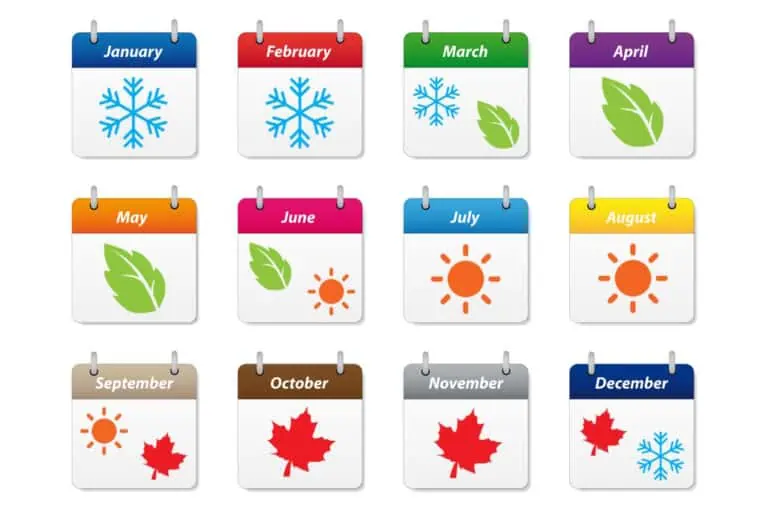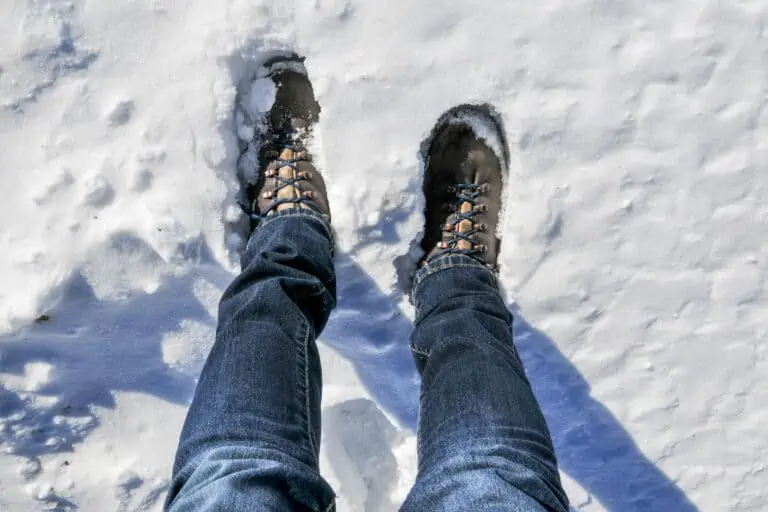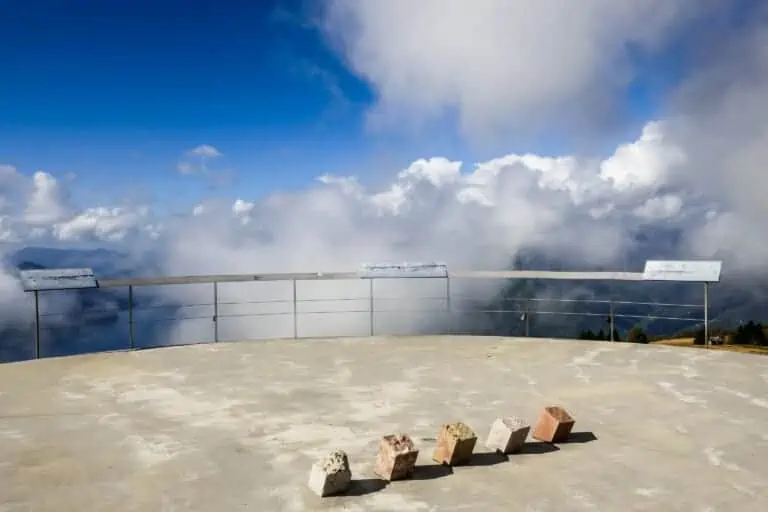Summer, spring and fall clothing and gear
How to dress for a summer, spring or fall holiday in Switzerland: quick summary
These guidelines apply to clothing for spring (March, April, May, June), summer (July, August, mid-September) and autumn (mid September, October and mid-November):
- Protection from the sun is essential in each season. The Swiss sun can be very bright, especially on reflecting lake or snow surfaces. That’s why sunglasses, sunscreen and a cap or hat are important.
- Dress in layers. That’s the best way to adapt to the temperatures that can vary a lot between regions and altitudes.
- Solid shoes and comfortable clothes are sufficient for low-key activities such as city trips and scenic boat or train rides. But you’ll need additional gear for hiking, biking and adventure activities.
11 unmissable clothing items for your Switzerland packing list
Apart from obvious items such as underwear and socks, these 11 items are unmissable for each summer, spring and autumn Switzerland trip:
- a pair of sunglasses, preferably with side protection and category number 2 or 3;
- sunscreen with a high protection factor;
- a cap or hat, to protect yourself from the sun and to provide some extra warmth at higher altitude;
- solid, well worn-in and waterproof shoes with good grip;
- a lightweight waterproof jacket or parka with a hat;
- a pair of (thin) gloves for extra warmth at mountain tops;
- comfortable long trousers that provide protection against rocks, low bushes, insects and ticks;
- several thin fleece or softshell vests or sweaters;
- several short- or long-sleeved T-shirts;
- an anti-theft wallet belt for your valuables;
- a comfortable backpack that can carry the maximum amount of items you need for your day trips.
What to wear for low-altitude sightseeing: city trips, scenic rides
If you plan to do some relaxed Switzerland sightseeing at low altitude, you won’t need many special items. Examples are city trips, town hikes, boat rides and train rides. The basic packing list will do.
You may want to consider these additional clothes:
- neat long trousers, skirt, dress and/or shirt if you want to visit fancy restaurants;
- swimwear;
- light backpacks and/or foldable shopping bags for city visits;
- umbrella.
How to dress for mountain top visits
The temperature at Swiss mountain tops is much lower than in the valleys. This is a rule of thumb: with every 100 m (328 ft) of gaining height, the temperature drops 0.7 to 1.0 °C (1.8 F). Hence:
- You’ll have to dress in several layers if you plan to visit the mountains. This is even more important if you plan a low-altitude activity, such as a valley hike, on the same day. You’ll have to be prepared for low temperatures and wind in the mountains, and for sun and warmth in the valleys.
- Thin (fleece) vests, shirts and a water- and windproof coat are perfect for such days. You may prefer a somewhat thicker (down) jacket if you visit the Swiss peaks in spring or autumn.
- Don’t forget the basic packing list items, especially your sun protection and extra gloves and a hat for additional warmth.
- You may like zip-off pants for days with varying temperatures. We personally prefer long trousers, even at low altitude and even if it’s warm, because they offer better protection from the sun and insects. But that’s a personal choice.
- Make sure you have enough free space in your backpack to store the items you don’t need at lower altitude.
Clothes and gear for mountain hiking
- Again, wearing several layers of thin clothing is most comfortable and sun protection is essential. The sun can be bright, and weather in the mountains can change quickly, even during a short hike.
- Wear hiking boots, unless you plan to walk on paved or easy trails only. Regular sports shoes are not convenient and even not suitable on most trails. Hiking boots come in different categories, based on the difficulty of the terrain for which the shoes are designed. A specialized sports store can help you make the right choice. Waterproof shoes are best. It also helps if you’re used to your shoes and if you’ve used them a lot before your hikes in Switzerland.
- Take along rainproof clothing and an additional thin (thermal) sweater.
- Wear thick socks, preferably seamless. This can prevent you from getting blisters.
- A pair of long trousers offers the best protection against the cold, heat, sun and insects. Ticks are a special concern. They can hide in low vegetation such as grass and low bushes. Bare ankles and legs are much more exposed to ticks. Long trousers also limit the chances of getting hurt by bushes or rocks.
- Use one or two lightweight trekking poles. They’re convenient for both descending and ascending, and indispensable on difficult or snowy terrain.
Find additional packing tips in our hiking preparation guide.
What to wear when (mountain) biking
Special bike clothes, full-finger gloves, sunglasses or goggles and a helmet are indispensable when biking. If you plan to bike in alpine terrain, you’ll need extra protection. Use knee caps and possibly elbow and back protection too.
Mountain bikes and gear can be rented in Switzerland.
Gear required for adventure sports
You may book an adventure activity such as paragliding, bungee jumping, skydiving or river rafting. In nearly all cases, the appropriate gear is included in the price or it can be rented on the spot. Check the specifics for each activity: the conditions may vary.
Winter clothing and winter gear
How to dress for a winter stay in Switzerland: quick summary
- For sightseeing, regular warm clothing is sufficient.
- You’ll need waterproof and windproof clothing for snow activities.
- Additional gear is required for winter sports like skiing.
- If you don’t have your own clothes and gear, you can buy or rent them from many Swiss stores.
What to wear for a winter city break
If you visit Swiss cities in winter, regular warm clothes will do. Temperatures will often be mild in larger cities, as they’re at low altitude. But it can get cold as well.
Dress in several thin layers. Fleece is a good material as it’s thin and warm. If you get cold quickly, thermal underwear is comfortable. Use a thick warm jacket. Wear comfortable, solid shoes.
Also bring along a scarf, hat, (leather) gloves and sunglasses.
What to wear for mountain visits and snow activities
Dress in layers if you get out in the Swiss snow or if you visit high mountains. Layers isolate your body warmth. They allow you to adapt to different temperatures throughout the day. Wear a thin layer on your body (e.g. thermal underwear), then a thicker layer (e.g. a fleece sweater) and a warm, waterproof jacket on top.
This is a packing list for winter hiking:
- thermal underwear or other thin, warm layers;
- warm socks, for example ski socks;
- waterproof, solid hiking boots with good grip;
- warm pants;
- a warm, waterproof and windproof jacket;
- gloves;
- a scarf or neck warmer;
- a hat or headband;
- sunglasses;
- optionally: hiking poles.
For snow activities such as sledding and snow tubing, and for long periods in the outdoors, also pack these items:
- snow boots;
- waterproof snow pants.
Which outfit to use for skiing or snowboarding
You need special equipment for skiing and snowboarding. Use warm, breathable, flexible jackets and pants on top of thinner layers. The jacket and pants should keep out water, snow and wind. Bright colors are safe, as they’ll make you visible against the white snow.
You need these items when skiing or snowboarding:
- warm, thin clothes under your ski gear. Thermal underwear and fleece sweaters are recommended.
- a ski jacket. Ski jackets have a snug fit, which is best for agility. They’re also flexible, breathable, waterproof and windproof.
- ski pants. They have a tight fit with elastic bands that fit around the ski boots. For snowboarders, a loose fit is usually better.
- ski socks. They’re thick and long, so they cover your ankles and calves. Ski socks have extra cushioning at the shin and toes for a comfortable fit in ski boots.
- ski gloves;
- a neck warmer;
- ski sunglasses or ski goggles. Ski goggles are different from sunglasses: they’re thicker, larger and held in place with a strap. This helps to protect your eyes and upper face.
- skis, ski boots and poles, or a snowboard and snowboard boots;
- a helmet.
How to protect yourself from sunlight in the snow
It’s important to protect yourself from harmful UV rays in the snow. The white surface of the snow reflects the sunlight and makes it extra bright.
UV rays are more powerful at higher altitude. The atmosphere is thinner in the mountains and absorbs less UV radiation.
Always wear sunglasses. Moisturizing eye drops can help if you have sensitive eyes. Use high-factor sunscreen every two hours. Lip balm with UV protection is recommended too.
Sunglasses suitable for snow
Wear sunglasses that are suitable for snow and bright sunlight. Use a large model that blocks sunlight from all angles, including the top and the sides of your eyes.
Sunglasses often come in categories ranging from 0 to 4. The lower the number, the lighter the lens tint and the more light will reach your eyes. Higher numbers indicate dark lenses that transmit less light and UV rays. Category 3 is good for a snow holiday.
Sunglasses prevent dry eyes, irritation and vision damage. They reduce glare caused by UV rays that are scattered around by snow. Sunglasses also protect against wind and dust.
Shoes, socks and snowboots
Wear sturdy hiking shoes. Sneakers are not sufficient. Your shoes should be warm and provide good grip. You can use thermal soles or wool insoles for extra warmth.
Use warm, long socks that cover your ankles and calves. Thin thermal socks along with regular socks are fine too.
Hiking shoes shouldn’t be moisture permeable. There are sprays and creams to make your shoes’ material waterproof.
For activities like sledging, snowtubing and playing in the snow, snow boots are more comfortable. These are waterproof mid-calf boots, often with a warm lining. Snowboots have wide soles with profiles that offer extra grip in the snow.
Don’t accidentally buy or rent ski boots. These are hard boots with a fixed, angled position to fit on skis.
For additional grip on slippery surfaces, you can attach snowsteps or snowspikes to your shoes or boots.
Snowshoes for snowshoe hiking
Some winter trails in Switzerland are not suitable for regular hiking, but only for snowshoe hiking. Snowshoes are large, flat, oval-shaped soles. You attach them under your own shoes or boots. The broad surface distributes your weight, so that you won’t sink into the snow.
Snowshoes are mostly made of lightweight materials such as aluminum or plastic. You’ll use them combined with trekking poles.
Winter coats and jackets
Winter jackets for a stay at high altitude and for snow activities should be warm, waterproof and windproof.
They should also be large enough, allowing you to add multiple layers of clothes underneath. Make sure that the sleeves are long enough, so that there’s no gap between the sleeve and your glove. Also check if the jacket sufficiently covers your neck and throat.
Ski jackets or down jackets are good options for a winter stay in the Swiss Alps.
Winter pants
Regular pants with thermal underwear can be sufficient if you’ll only be hiking in the snow.
If you’ll be playing in the snow, use waterproof and windproof snow pants or ski overalls. They have elastic bands to put around your boots or your ankles. This design retains warmth. It also makes sure that no snow can come in at the edges of your shoes or boots.
Gloves and mittens
Wear thick, waterproof and windproof gloves when playing in the snow. Thinsulate can be useful. This microfibre material retains warmth and is breathable and washable.
Ski gloves are extra thick. They’re great if you expect very cold circumstances, but they’re not flexible.
Ski mittens provide even better comfort and warmth, but they’re less handy if you want to grab things. You can wear an underlayer of thin thermal thermal gloves. These will still protect your fingers from the cold if you take off your mittens.
If you plan to take many pictures, you may prefer thin gloves. They allow you to control your camera more easily. There are special gloves for operating mobile devices too. The thumb and index finger contain material to which touchscreens respond.
Scarves and neck warmers
Most winter coats don’t perfectly fit around your neck and throat. A warm, flexible scarf can cover the open space.
A neck warmer or buff is even easier. This is a kind of bandana, to be put around your neck. You can also pull it up over your chin or ears, or even around your entire face. There are thin versions suitable for summer, and winter versions with fleece or thermal material for winter.
Winter hats and ear bands
It’s important to protect your ears against the cold. Wear a winter hat or ear bands. Fleece, (merino) wool, and thinsulate are good materials.
Buying clothes and gear in Switzerland
It’s easy to buy clothes and sports gear in Switzerland. There are many stores. The ones in snow resorts often sell winter gear all year long. Stores in other areas usually offer winter clothes from October to February or March, and summer clothes and gear from April to September.
Examples of large Swiss chains selling clothes and (winter) sports gear are:
- Intersport. Intersport has about 200 shops in Switzerland. Many are located in tourist towns and sports resorts, such as St. Moritz, Davos and Grindelwald. A few Intersport shops can also be found at the valley stations of cable cars.
- Decathlon. Decathlon is a relatively affordable brand. It has stores throughout Switzerland. They’re usually not in main cities and not in ski resorts. Instead, Decathlon stores can be found in smaller towns close to large tourist towns.
- Migros SportXX. These stores can be found in and near many larger towns. Examples are Geneva, Basel and Zurich. There are no shops in ski resorts. Use these stores if you enter Switzerland from a large city, before you travel to the mountains.
- Ochsner Sport. Ochsner Sport has stores in and near larger towns. They’re not in all ski and sports resorts, but often in a nearby town. An example is the shop in Brig near the mountain villages Zermatt and Saas-Fee.
Apart from chain stores, you’ll find lots of other local shops and boutiques with clothing.
Renting clothes and sports gear in Switzerland
It can be useful to rent clothes or sports gear in Switzerland. You can best rent items:
- that you don’t want to buy, because you’ll only use them during your Switzerland holidays.
- that are large and require a lot of packing space. Examples are skis, mountain bikes, snowboards and thick jackets.
- that are for special activities you’ll only do once or a few times. Examples are snowshoes and sleds.
You can rent sports gear in many stores in Swiss mountain resorts. Some stores also offer regular clothing for rent. Find sample rental prices for winter gear here.
Intersport is the recommended company to rent summer and winter gear in Switzerland. They cater to tourists from abroad and have lots of stores in mountain resorts. You can rent mountain bikes, skis and snowboards, sportswear, winter clothes and accessories. You can book your gear online in advance, or pick your items at the spot in one of the Intersport stores.
Other Swiss chain stores with rental option are available in many towns, but not always in ski resorts. They mainly offer in renting out specialized mountain gear, not regular clothes. Examples are:
Apart from these chain stores, there are many more stores with rental options in ski and mountain resorts.
You can rent gear at the valley stations of some popular cable cars and mountain trains as well.
Extra safety: clothing with RECCO reflectors
Some clothes contain RECCO reflectors. They can be useful if you plan skiing or hiking tours in remote areas. Such reflectors help you to get traced in case you get caught by an avalanche or get lost in the outdoors.
- Reflectors are small, lightweight transponders. They’re based on radar technology. The reflectors help rescue workers track your position.
- Reflectors can be integrated into jackets, helmets and other (winter) equipment. Gear with a reflector can often be recognized by a RECCO label.
- Avalanche transceivers, also called beacons, are different from avalanche reflectors. Avalanche transceivers are larger and more powerful devices, meant for companion rescue. They run on batteries and emit a pulsed radio signal. They are not required for average snow holidays in Switzerland.
More practical info about seasons and weather in Switzerland



